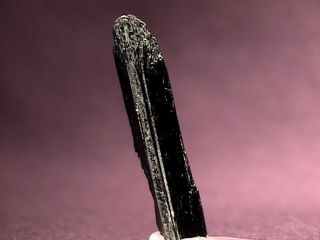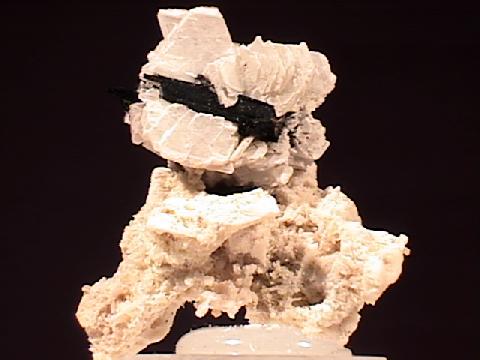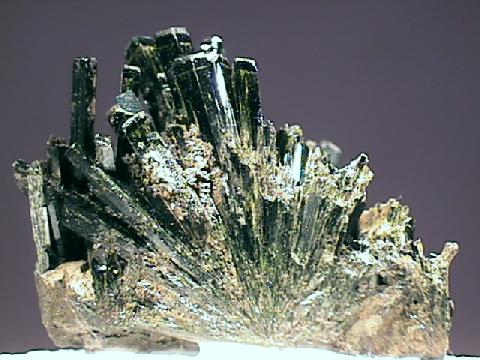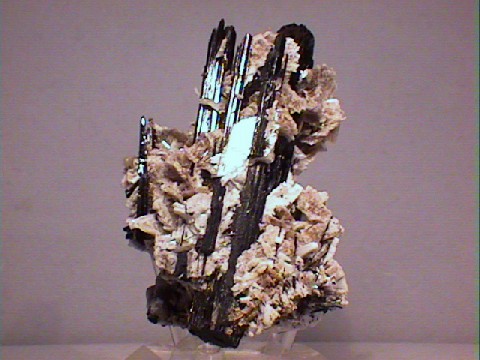 THE MINERAL AEGIRINE
THE MINERAL AEGIRINE
- Chemistry: NaFeSi2O6 , Sodium Iron Silicate.
- Class: Silicates
- Subclass: Inosilicates
- Group: Pyroxenes
- Uses: Only as mineral specimens.
Specimens
Aegirine, which is listed in some guides as acmite, forms impressive crystals that have become classics among collectors. These tall opaque monument-like crystals that jut majestically out from their host rocks are simply splendid. The steeply inclined pyramid on top of the prismatic crystals is very characteristic and thus diagnostic of aegirine. Its alternate name, acmite, comes from the Greek word for point. The name aegirine is after the Teutonic god of the sea, Aegir, and was given when the first specimens of the mineral were discovered in Norway.
Aegirine is difficult to distinguish from its close cousin augite. Under normal circumstances, the steep pyramids of aegirine are the only point of differentiation (excuse the pun).
PHYSICAL CHARACTERISTICS:
- Color is black to greenish or brownish black.
- Luster is vitreous.
- Transparency: Specimens are generally opaque to translucent.
- Crystal System is monoclinic; 2/m
- Crystal Habits include long prismatic crystals terminated by a steep asymmetrical pyramid. Also as disseminated grains, compact and fibrous.
- Cleavage is perfect in two directions at near 90 degree angles.
- Fracture is uneven.
- Hardness is 6 - 6.5
- Specific Gravity is approximately 3.5 - 3.6 (above average for translucent minerals)
- Streak is white or gray.
- Other Characteristics: Splinters or thin edges are translucent green.
- Associated Minerals are augite, nepheline, andradite, barite, quartz, spessartine, riebeckite, biotite, sodalite and albite
- Notable Occurrences include Mont Saint-Hilaire, Quebec, Canada; Kongsberg, Norway; Narsarssuk, Greenland; Kola Peninsula, Russia; Magnet Cove Arkansas, USA; Kenya; Scotland and Nigeria.
- Best Field Indicators are crystal habit (especially its steep pyramids), density, cleavage, color and hardness.
 Amethyst Galleries' Mineral Gallery MINERALS |

AEGIRINE specimen aeg-1
$ 30.00
$ 30.00
Dims: 1.5" x 0.3" x 0.3" (3.8 x 0.8 x 0.8 cm)
Wt: 8.1 g w/ base
Mont Saint-Hilaire, Quebec, Canada
This thumbnail specimen consists of a single crystal of Aegirine- it is in excellent condition, showing only a tiny spot of damage at its very tip, and has good monoclinic crystal form, with well-defined edges and clean faces that have a vitreous luster. The crystal's color is black and it is completely opaque. A small trapezohedral analcime crystal partially protrudes form the Aegirine about halfway up its length; it is in excellent condition, and its form is easily discernable.


aeg-1 ($ 30.00)
Mont Saint-Hilaire, Quebec, Canada

AEGIRINE specimen aeg-2
$ 50.00
$ 50.00
Dims: 2.7 x 1.5 x 1.2" (6.9 x 3.8 x 3.0 cm)
Wt: 1.7 oz. (48.7 g)
Zomba Malawi, South Africa
A few intergrown Aegirine crystals rise up from the crystalline orthoclase base of this specimen. Only one of the Aegirines is complete, so I will concentrate on it alone. The crystal has dimensions of 1.7 x 0.3 x 0.3" (4.3 x 0.8 x 0.8 cm) and is in very good condition, showing almost no damage. It is also not quite complete, as there is a small amount of material missing out of its base, but this is due to natural occurrences. It shows moderately good crystal form, with some areas containing well-defined edges and flat faces. Its luster is either vitreous or waxy, depending on what part of the surface is being studied. Its termination seems to have been interrupted through intergrowth with the host rock or some other material, as it is incomplete also. The orthoclase base on which it rests shows very good monoclinic prismatic form. The crystals have a dirty, creamy-white coloration and a bright pearly-to-vitreous luster. Close examination of the base will reveal what look like a few tiny zircon crystals that are growing among the orthoclases.


aeg-2 ($ 50.00)
Zomba Malawi, South Africa

AEGIRINE specimen aeg-3
$ 90.00
$ 90.00
Dims: 2.6 x 1.0 x 0.7" (6.6 x 2.5 x 1.8 cm)
Wt: 26.4 g
Zomba Malawi, South Africa
This large thumbnail specimen consists of a "parallel association" of prismatic Aegirine crystals. On one hand, there seem to be only two crystals at their bases. However, their form breaks down into smaller prisms that are partly-intergrown but definitely integral. These do not seem to show any human-induced damage, and the largest measures nearly 2.4" (6 cm) in length. Their monoclinic prismatic form is extremely warped and cannot be identified as such, but they do still have a definable form. Their black color has very strong dark green highlights, and even the thinnest crystals are thoroughly opaque. There are a few bits of intergrown orthoclase at the base of the specimen, but they show no crystal form.


aeg-3 ($ 90.00)
Zomba Malawi, South Africa

AEGIRINE specimen aeg-4
$ 105.00
$ 105.00
Dims: 3.2 x 1.2 x 0.8" (8.1 x 3.0 x 2.0 cm)
Wt: 2.3 oz. (64.5 g)
Zomba Malawi, South Africa
A "parallel association" of heavily-intergrown Aegirine crystals make up the bulk of this specimen. As they are so intergrown, I will speak of them as a single unit. The crystal is in very good condition, as it shows only a small amount of damage besides the breakage surface at its base. Its monoclinic prismatic form is fair due to its heavy intergrowth and a large patch of partly-healed damage that envelops almost an entire face. Its termination is natural but heavily disseminated and warped, with portions covered by a thin, dull, brown coating. Its intact edges, however, are well-defined, and most of its faces are clean and possess a vitreous luster. The Aegirine has a black coloration and is completely opaque, even in halogen light. There is no host rock present on the piece, but there are several small albite crystals that are partly embedded along its prism length. These do not exceed 0.4" (1.0 cm) in any dimension, and have the standard milky-white coloration and pearly luster. Though several of them are damaged, most are intact and have excellent monoclinic prismatic form, with sharp edges and clean, smooth faces.


aeg-4 ($105.00)
Zomba Malawi, South Africa

AEGIRINE specimen aeg-5
$ 42.00
$ 42.00
Dims: 1.7 x 0.5 x 0.3" (4.3 x 1.3 x 0.8 cm)
Wt: 9.6 g w/ base
Mount Saint Hilaire, Quebec, Canada
This single Aegirine crystal is in excellent condition, showing no human-induced damage that I can see. Its monoclinic prismatic form is very good, showing disseminated but definite edges and striated but clean faces that possess a vitreous luster. It appears to be completely black in coloration and is opaque. There is no host rock present on the piece, but a few tiny chabazite crystals rest near its termination, and what look almost like tubular calcite or dolomite formations rest on one prism face. The piece is hot-glued onto a flat, square acrylic base.

aeg-5 ($ 42.00)
Mount Saint Hilaire, Quebec, Canada

AEGIRINE specimen aeg-6
$ 52.00
$ 52.00
Dims: 2.5 x 0.3 x 0.3" (6.4 x 0.8 x 0.8 cm)
Wt: 7.4 g
Mount Malosa, Malawi
This doubly-terminated Aegirine crystal is in excellent condition, showing almost no visible damage, and has slightly warped but good monoclinic form. Its edges are well-defined though slightly disseminated, and its faces are striated but clean and possess a vitreous luster. It is essentially black in color, with green highlights, and is almost completely opaque. There is no host rock of any sort present.


aeg-6 ($ 52.00)
Mount Malosa, Malawi

AEGIRINE specimen aeg-7
$ 25.00
$ 25.00
Dims: 1.3 x 1.3 x 0.8" (3.3 x 3.3 x 2.0 cm)
Wt: 14.8 g w/ base
Mount Saint Hilaire, Quebec, Canada
Less than 12 small Aegirine crystals are embedded in the albite host rock of this thumbnail specimen. They do not exceed 0.7" (1.8 cm) in length or 0.1" (3 mm) in diameter, and are in moderately good condition, as one of the largest crystals is obviously broken. The others are in good condition, though they appear to be slightly warped due to growing conditions. Their monoclinic form is still discernable, however, and all have well-defined edges and striated but clean faces that possess the standard vitreous luster. They are essentially black in color and completely opaque. The albite host rock that holds the Aegirines appears to be somewhat weathered, but is made up of crystals that show excellent pseudohexagonal triclinic form. Their color ranges from milky white to cream, and their luster is dull and waxy. The specimen is hot-glued onto an acrylic base.

aeg-7 ($ 25.00)
Mount Saint Hilaire, Quebec, Canada

AEGIRINE specimen aeg-8
$ 46.00
$ 46.00
Dims: 2.2 x 0.8 x 0.7" (5.6 x 2.0 x 1.8 cm)
Wt: 12.5 g
Mount Saint Hilaire, Quebec, Canada
Two discernable Aegirine crystals intersect with the natrolite base of this specimen. The smaller of the two is mostly incomplete, but the larger is complete and measures 0.8" (2.0 cm) in length. It is in very good condition, showing only a small amount of damage on its termination tip that is not at all obvious. The crystal has very good monoclinic prismatic form, with slightly disseminated but well-defined edges and clean faces that possess a vitreous luster. It has a basic black coloration and is completely opaque. Accompanying the Aegirines are several tiny, red rhombohedral crystals- they could be chabazite or calcite, but I would guess chabazite, due to the zeolitic base, their deep rust-red color and the fact that this locality produces chabazite. The natrolite base on which they rest impresses me greatly, as it consists of the bottom portion of a very large crystal, with an intact base (or maybe it is a termination??). A much smaller, broken natrolite intersects it near the broken Aegirine, but there is no host rock present.

aeg-8 ($ 46.00)
Mount Saint Hilaire, Quebec, Canada

AEGIRINE specimen aeg-9
$ 30.00
$ 30.00
Dims: 2.3 x 1.3 x 1.0" (5.8 x 3.3 x 2.5 cm)
Wt: 1.48 oz. (42.2 g)
Mount Saint Hilaire, Quebec, Canada
At least 14 different Aegirine prisms permeate the microcline base of this thumbnail specimen. The longest of these crystals reaches 2.3" (5.8 cm), and like almost all of the others, is damaged and missing its termiation. All have good monoclinic prismatic form with well-defined edges and clean faces. They have the standard black coloration and bright pearly-to-vitreous luster of Aegirine, and are completely opaque. They are accompanied by two partly intergrown clusters of tiny brown needles- I suppose that these could actually be more Aegirines, but I cannot be sure. The microcline base on which they rest is crystalline and shows moderate damage.

aeg-9 ($ 30.00)
Mount Saint Hilaire, Quebec, Canada

AEGIRINE specimen aeg-10
$ 40.00
$ 40.00
Dims: 1.2 x 0.9 x 0.6" (3.0 x 2.3 x 1.5 cm)
Wt: 17.9 g w/ specimen box
Mount Malosa, Zomba District, Malawi
A crust made up of several protruding Aegirine crystals makes up this thumbnail specimen. Though there are spots where several crystals have obviously broken off, those that are intact are in excellent condition and reach lengths of up to 0.9" (2.3 cm). Their monoclinic prismatic form is likewise excellent, with well-defined edges and very clean faces that possess a bright pearly-to-vitreous luster. They have the standard black color with dark green highlights of their species and are essentially opaque. The crystals become heavily intergrown at their bases, and so form the base from which they extend. The specimen is affixed inside a plastic specimen box with a hot-glue.

aeg-10 ($ 40.00)
Mount Malosa, Zomba District, Malawi

AEGIRINE specimen aeg-11
$ 25.00
$ 25.00
Dims: 1.2 x 1.0 x 0.9" (3.0 x 2.4 x 2.2 cm)
Wt: 10 g
Mount Saint Hilaire, Quebec, Canada
At least 9 Aegirine crystals extend from the albite base of this thumbnail specimen. These crystals are in fair condition, as all appear to be broken and incomplete- however, none of the breakage appears to be fresh. Its monoclinic form is quite good, though none of the crystals have terminations. All have a black color and pearly-to-vitreous luster, and are opaque. They are accompanied by many tiny albite blades, many of which are broken.

aeg-11 ($ 25.00)
Mount Saint Hilaire, Quebec, Canada

AEGIRINE specimen aeg-12
$ 72.00
$ 72.00
Dims: 2.5 x 1.7 x 1.3" (6.4 x 4.3 x 3.4 cm)
Wt: 1.7 oz. (48 g)
Mount Saint Hilaire, Quebec, Canada
Scores of Aegirine prisms, spikes and needles permeate the feldspar host of this large hand specimen. These crystals reach lengths of nearly 2" (5 cm) and are generally in excellent condition, though several of the finer ones are broken. All have good monoclinic prismatic form and have a brown-black color and vitreous luster. They are more or less completely opaque. The host material is made up of countless albite platelets that are intermixed with several microcline crystals, most of which are incomplete or warped.


aeg-12 ($ 72.00)
Mount Saint Hilaire, Quebec, Canada

AEGIRINE specimen aeg-13
$ 55.00
$ 55.00
Dims: 1.74x0.69x0.59" (4.42x1.76x1.50cm)
Wt: 0.32oz (9.0g)
Mt. St. Hilaire, Quebec, Canada
This is a nice crystal of black aegirine, with white albite crystals adding a nice contrast. The aegirine is actually a very deep brown and is slightly translucent, with adamantine luster and with internal fractures resulting in brown sparkles along the length of the crystal.


aeg-13 ($ 55.00)
Mt. St. Hilaire, Quebec, Canada

AEGIRINE specimen aeg-14
$ 34.00
$ 34.00
Dims: 1.47x0.98x0.73" (3.73x2.48x1.85cm)
Wt: 15.5ct (3.1g)
Zomba, Malawi
This cluster of aegirine crystals is dominated by it's largest member, but there are at least a dozen crystals present. All are opage, black, and have a vitreous luster. A loupe reveals a small amount of damage to a few of the crystals, which also reveals that the aegirine is actually green and transparent (only visible due to near-surface internal fractures). Also, there are a few contact impressions of lost aegirine crystals on the sides of some of these, especially the largest.


aeg-14 ($ 34.00)
Zomba, Malawi

AEGIRINE specimen aeg-15
$ 75.00
$ 75.00
Dims: 2.13x1.64x0.64in (5.41x4.18x1.63cm)
Wt: 1.01oz (28.7g)
Mt. St. Hilaire, Quebec, Canda
Several large dense clusters of black aegirine crystals rest against a backdrop of creamy while microcline and albite.


aeg-15 ($ 75.00)
Mt. St. Hilaire, Quebec, Canda